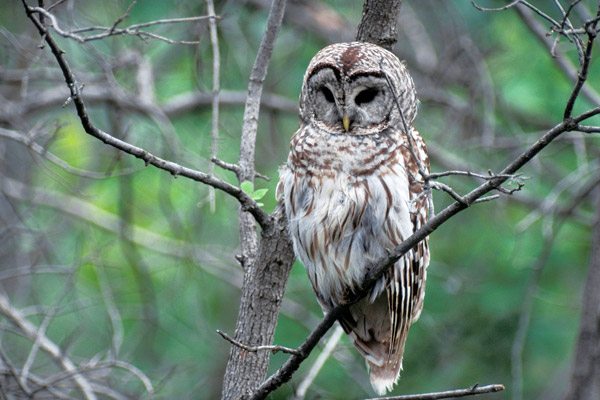
December: Who Cooks For You?
By Dan Zarlenga, Missouri Department of Conservation
One might think that venturing outside into nature in the middle of a December night would be a recipe for solitude. The rhythmic pulsation of the insects we hear during the warmer months is now gone, and the cold, still air is quiet as a whisper. Suddenly, a loud, raucous call breaks the silence! The strange voice might sound like anything from a mournful ghost, to a maniacal monkey laughing at the moon, to a scream of terror.
Congratulations, you’ve probably just come ear-to-ear with a barred owl.
The barred owl is one of Missouri’s most common owl species. They can be found in just about any park, conservation area or stand of woods near where you live. Barred owls may even be in your own neighborhood or backyard. They also live along rivers, lakes, and swamps. You might even occasionally catch a glimpse of one during the day.
The barred owl is named for the brown streaks, or bars, along its wings. At nearly two feet from bill to tail and sporting a wingspan of up to four feet, barred owls are one of our largest owls. Only great horned owls, for which barreds are sometimes confused, grow larger. There are several other differences, too. Barred owls have rounded heads, while the great horned owl has prominent ear tufts. The eyes of barred owls are jet black, like two round pieces of coal, distinct from many other owls who have yellow eyes.
While the call of the great horned owl is a low, quiet hoot, barred owls make such a variety of vocalizations, it’s hard to believe all the sounds are coming from the same animal. Get two or more of them “talking” together, it can be quite a wild and crazy conversation. Many people describe their most distinctive call as sounding like “Who, who, who cooks for you? Who cooks for you all?”
Curious why an owl would be asking such a question, since these predatory birds eat their food raw. They mainly dine on rodents like mice, voles, or maybe an unlucky rabbit or squirrel. It turns out that food is not what they’re asking about this time of year.
December is the beginning of mating for barred owls. So right now, they are sending out calls looking for love as part of their courting ritual. They rely on these vocalizations to find and attract mates. After mating, the females usually nest in tree cavities bored out by woodpeckers, or former nesting spots used by hawks or squirrels. You can find lots more information on these and all of Missouri’s owls in the MDC online field guide at MDC.mo.gov. So, take a stroll outside on a quiet evening this month. If you suddenly hear a strange call coming from the darkness asking, “Who cooks for you?”, don’t be alarmed. Perhaps it’s a barred owl who simply wants to know a good place to bring a dinner date.


